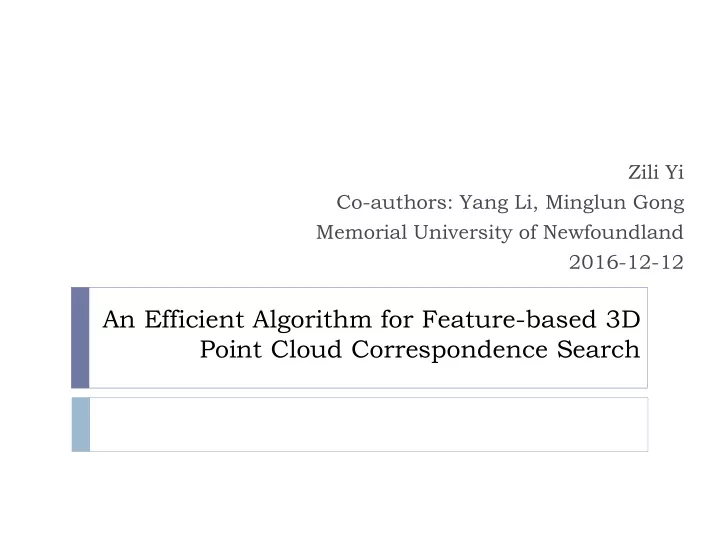

Zili Yi Co-authors: Yang Li, Minglun Gong Memorial University of Newfoundland 2016-12-12 An Efficient Algorithm for Feature-based 3D Point Cloud Correspondence Search
Outline Introduction Background Method Results Conclusion
Introduction – Point Cloud 3D point cloud A versatile representation of 3D shapes Sources laser scanners estimated from stereo matching sampled from 3D surface models.
Introduction - 3D Point Cloud Correspondence 3D Point Cloud Correspondence to find the matching between the two sets of points Application building statistical shape models smoothly interpolating key Frames in cartoon animations morphing between shapes of disparate 3D Point Cloud Correspondence objects recognizing/classifying 3D objects
Introduction – previous methods Methods for Point Cloud Correspondence Rigid (transformation to correspondence) ICP , BMP Non-rigid (Pointwise/articulated correspondence) Feature-based Non-rigid BMP/ICP Feature-based Correspondence Matching between features rather than raw points Limitation of traditional feature-based algorithm Computation of features at multiple levels Inefficient when introducing smoothness term
Related topics Nearest Neighbor Search Space partitioning trees: K-d tree, VP-tree PatchMatch (for 2D image correspondence search) Combine randomized search and belief propagation 3D Point Cloud Features Unique Shape Context Point Feature Point Feature Histogram
Related topics Swarm Intelligence Artificial Bee Colony (ABC) Search optimal solutions Three types of bees in a Colony Scout Search food sources randomly Employed bee Search food sources among neighbors Onlooker Search food sources from other colonies
Method Framework 3D Feature Objective Function ABC-based Search Extraction Colorization Preparation Correspondence Result Optimization Converge Random Initialization K-Neighbor Caching Source Target Source Target
Method Objective S: Source, T: Target P ∈ 𝑇 , M(P) is the matching point of P α is the balance coefficient Geometric term Smooth term
Effect of Smoothness Term Force neighbors corresponding to neighbors
Optimization Process Searching scheme (iteratively and pointwisely)
Optimization Process
Optimization Technique Variable harmonic vs fixed harmonic during optimization Source Target Source α =0 α varying 0-0.95 α =0.95 (mesh) (mesh) (point cloud) result I result II result III
Qualitative Comparison
Efficiency An order of magnitude faster than brute-force search
Conclusion Strength Efficient Accurate Noise-robust Limitation Poor matching with giant shape difference Correspondence results on the tiger-horse dataset under different noise levels. In each test, both the target (left) and the source (right) point clouds are corrupted using Gaussian noise with standard variance of σ , where D is the diagonal length of the input point cloud.
Conclusion Strength Efficient Accurate Noise-robust Limitation Poor matching between shapes with giant difference Correspondence results on the tiger-horse dataset under different noise levels. In each test, both the target (left) and the source (right) point clouds are corrupted using Gaussian noise with standard variance of σ , where D is the diagonal length of the input point cloud.
Thank You!
Recommend
More recommend